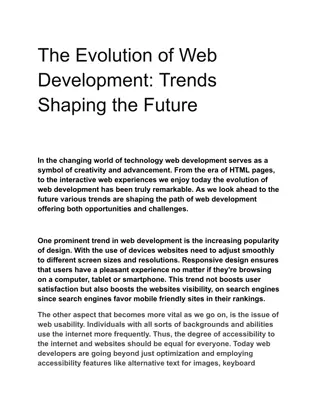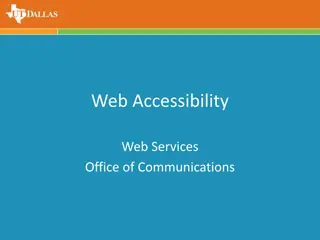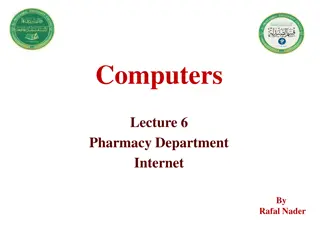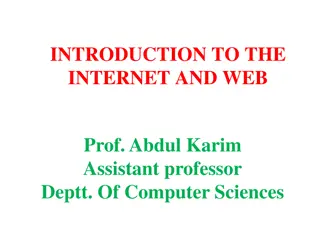Understanding the Structure and Evolution of the World Wide Web
Exploring the intricate network of the World Wide Web, this content delves into its origins, the distinction between the web and the internet, the concept of information and social networks, and the fundamental role of hypertext. It also discusses different methods of organizing information and highlights the significance of non-linear connections in the context of academic references and cross-references.
Download Presentation

Please find below an Image/Link to download the presentation.
The content on the website is provided AS IS for your information and personal use only. It may not be sold, licensed, or shared on other websites without obtaining consent from the author. Download presentation by click this link. If you encounter any issues during the download, it is possible that the publisher has removed the file from their server.
E N D
Presentation Transcript
Structure of The World Wide Web From Networks, Crowds and Markets Chapter 13 Eyal Feder Nov, 14
Not really The Web != Internet None of the are made of cats The World Wide Web is an application of the Internet https://www.youtube.com/watch?v=lskpNmUl8yQ
Information networks Vs. social networks The basic units connected (nodes) are pieces of information The edges symbolize some kind of connection between them Share a lot of the ideas mentioned in earlier sessions
Back to the web Created by Tim Burners-Lee A research project in 1989- 1991 at CERN An application of the internet Two basic features: Make documents on your computer publically accessible Easily access these documents using a browser
The web as a network The nodes are documents (pages) The edges are links (figure 13.2) How do links work? Hypertext
Hypertext (The coolest thing about the web)
Different ways to manage information Alphabetically Hierarchy (like folders) Classification systems All of these have one thing in common Linearrrr
Earlier non linear connections Academic references (also in legal decisions and patents) Relevant to the web?
Earlier non linear connections Cross-reference encyclopedia (figure 13.4)
Memex Vannevar Bush, 1945 Article: As We May Think Our memory is not linear. Hypothetical model the Memex Inspired the idea of hypertext
Introducing: Hypertext The ultimate reason text is blue. Invented by Burners-Lee The way web pages are connected An associative way to organize information
Static pages >> Query pages In the early days static pages of contact Today? More and more transactional actions, which create query pages
Importance of static pages The Backbone of the Internet Reliable over time Include most links Navigational vs. transactional Our focus when thinking about structure
Time for math! (just a little bit, sorry )
The web as a directed graph The best mathematical approximation a graph Why directed?
What is a path in a directed graph? A Path from node A to a node B in a directed graph is a sequence of nodes, beginig with A and ending with B, with the property that each consecutive pair of nodes in the sequence is connected by an edge pointing in the forward direction
What is Strong Connectivity in a directed graph? A directed graph is Strongly connected if there is a path from every node to every other node
The Concept of Reachability Since connectivity does not describe all of the connections in a graph, we need another concept Reachability Reachability describes the nodes that are reacheable from a certain node or vice versa How do we check this?
Strongly connected components Parts of a graph that have strong connectivity In other words a group of nodes in which each node is reachable from all other nodes. Formal: We say that a strongly connected component (SCC) in a directed graph is a subset of the nodes such that: (i) every node in the subset has a path to every other; and (ii) the subset is not part of some larger set with the property that every node can reach every other.
How does all that help us understand the web? We can map reachability Using the super-graph
History Short reminder the Web is not the Internet! Created in 1999 by Andrei Broder and his colleagues Used data from biggest search engine back then AltaVista. Afterwards reevaluated many times
Why a giant component? Counter-intuative, ha? Let s think probability
Different kinds of nodes In the SCC In the inbound part In the outbound part Tendrils Disconnected nodes
Limitations The bow-tie structure is a mile high view Not understanding the role of specific nodes (sites)
What is web 2.0? A concept made popular by Tim O railey in 2004 Basically the web s move towards a Prosumer crowd Three main charachteristics: (i) the growth of Web authoring styles that enabled many people to collectively create and maintain shared content; (ii) the movement of people s personal on-line data (including e-mail, calendars, photos, and videos) from their own computers to services offered and hosted by large companies; (iii) the growth of linking styles that emphasize on-line connections between people, not just between documents.
Different implications of web 2.0 Software that gets better as more people use it The wisdom of the crowds The Long Tail
A little bit more a bout the structure of the web From: Albert R., Jeong H, & Barabasi A. - Diameter of the World Wide Web (2000)
About the research Trying to map reachability on the web Their main finding the probability of a node to have k links (inbound and out) follow a power law Meaning the web is a Small World Graph, typically found in biological and social networks This was proven more by the short path research























